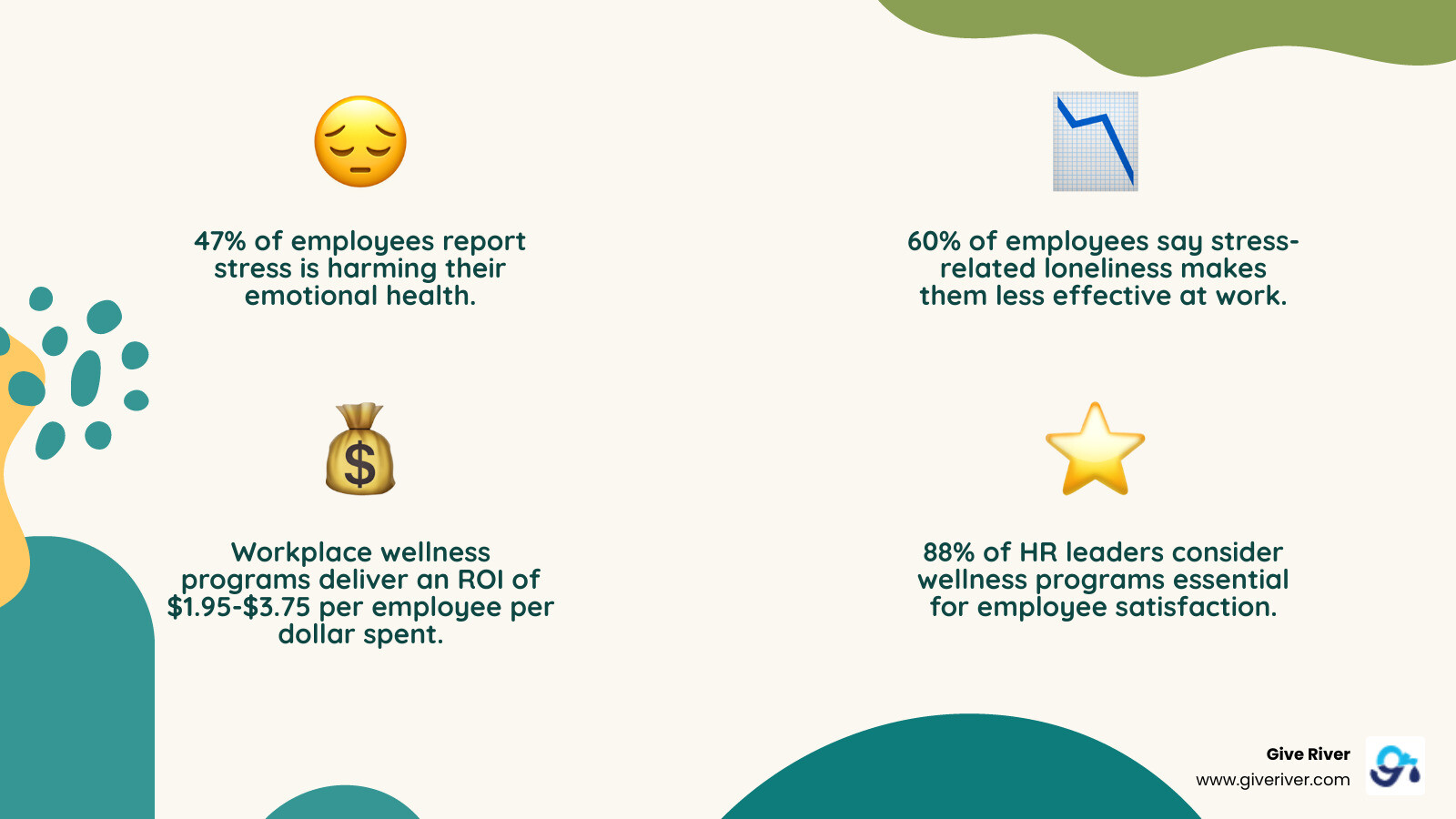Wellness Wonders: Creative Ideas for a Thriving Workplace
Transform your office! Get 50+ workplace wellness ideas to boost health, happiness, and engagement for your team.

Why Modern Workplace Wellness Ideas Matter More Than Ever
Workplace wellness ideas have evolved far beyond the traditional fruit bowl. With 47% of employees reporting that stress harms their emotional health, the modern workforce demands comprehensive solutions that address physical, mental, financial, and social wellbeing.
Top workplace wellness ideas include:
- Physical: Step challenges, ergonomic support, fitness classes.
- Mental: Meditation apps, flexible schedules, stress management.
- Financial: Planning workshops, budgeting resources.
- Social: Team volunteering, peer recognition programs.
- Environmental: Office plants, natural lighting.
The business case is compelling: these programs can deliver an ROI of up to $3.75 per dollar spent, and 98% of HR leaders report they reduce turnover. The challenge is moving beyond perks to create a culture of genuine wellbeing.
I'm Meghan Calhoun, co-founder of Give River. After two decades in high-pressure roles, I've learned that sustainable wellness must address the whole person. At Give River, we've seen how combining wellness with gratitude and generosity creates transformative experiences for employees and organizations alike.

Terms related to workplace wellness ideas:
Key Workplace Wellness Ideas to Boost Health, Happiness, and Engagement
At Give River, we believe true workplace wellness is a holistic ecosystem supporting every dimension of an employee's well-being. Employees who feel cared for are more engaged, productive, and loyal. Let's explore effective workplace wellness ideas to cultivate this environment.
Energize the Body: Physical Wellness Initiatives
A healthy body supports a healthy mind, impacting focus and mood. Physical activity is a cornerstone of comprehensive wellness programs.
- Step Challenges: Encourage movement with team-based competitions. Employees invited to a wellness challenge are over 8 percentage points more likely to exercise regularly.
- On-site or Virtual Fitness Classes: Offering accessible yoga, Pilates, or stretching sessions removes common barriers to exercise and improves physical, mental, and social well-being.
- Ergonomic Assessments: Since many employees sit for most of the day, providing ergonomic assessments for workstations can prevent discomfort and boost productivity. According to scientific research on ergonomic workstations, proper setup is key to long-term health.
- Healthy Snacks and Hydration Stations: Swap sugary treats for fruit and nuts, and ensure water is readily available to encourage better habits and boost energy.
- Walking Meetings: Taking meetings outside can stimulate creativity and productivity while promoting physical activity.
- Promoting Local Health Events: Sponsoring employee teams for community 5Ks or charity walks fosters a sense of shared purpose and achievement.
Nurture the Mind: Mental and Emotional Health Support
Mental health is a critical component of a holistic wellness strategy. Prioritizing it demonstrates genuine care and fosters a resilient, supportive culture.
- Meditation Apps and Quiet Zones: Provide access to apps like Calm or Headspace or designate a "zen zone" for relaxation. Meditation is proven to improve mood, focus, and sleep.
- Mental Health First Aid (MHFA) Training: Empower staff to recognize and respond to signs of mental health challenges, destigmatizing the issue and building a support network.
- Flexible Work Schedules: Offering flex-time or remote work options can significantly reduce stress and burnout by giving employees more autonomy.
- Promoting Employee Assistance Programs (EAPs): Regularly remind employees about the confidential counseling, financial advice, and legal services available through your EAP.
- Stress Management Workshops: Host sessions on mindfulness and resilience to provide employees with practical tools to steer daily challenges.
- Dialogue Spaces: Create voluntary, safe spaces for employees to openly discuss sensitive topics, encouraging empathy and support.
Build Security: Financial Wellness Programs
Financial stress is a powerful disruptor of employee well-being. Integrating financial wellness into your corporate program is a strategic move that reduces anxiety and distraction.
- Financial Planning Workshops: Offer seminars on budgeting, debt management, and investing to empower employees to make informed decisions.
- Access to Financial Advisors: Partner with firms to offer free or subsidized one-on-one consultations for personalized guidance.
- Student Loan Benefits: Offering repayment assistance or refinancing options can be a significant differentiator and a huge relief for many employees.
- Retirement Seminars: Provide clear, accessible information about company retirement plans to alleviate a major source of anxiety.
- Lifestyle Spending Accounts (LSAs): Offer flexible funds for well-being expenses, allowing employees to invest in their personal priorities.
Strengthen Bonds: Social and Community Wellness
A strong sense of community at work drives engagement, morale, and retention. Social connections foster a supportive environment where employees feel they belong.
- Team Volunteering: Organize opportunities for teams to volunteer together, which cultivates camaraderie and a shared sense of purpose.
- Company Book Club: Encourage intellectual growth and team connection outside of work-related discussions.
- Healthy Potlucks: Promote healthy eating and social interaction by encouraging employees to share nutritious, homemade dishes.
- Peer Recognition Programs: Implement a system for employees to appreciate each other. While platforms like Bonusly and Kudos offer peer recognition, Give River stands out by combining it with a unique game of good deeds that fuels both engagement and generosity.
- Team-Building Events: Activities like field days or sports games boost teamwork and help colleagues connect on a personal level.
- Mentorship Programs: Pairing experienced employees with newer ones fosters growth and meaningful connections, which can lead to 25% higher retention rates.
Creative and Low-Cost Workplace Wellness Ideas
Not every impactful workplace wellness idea requires a large budget. These creative options focus on involvement and a genuine commitment to well-being.
- Gratitude Circles or Journals: Start meetings with a brief gratitude exercise or provide journals to promote happiness and positive thinking.
- Wellness Newsletters: Share health tips, recipes, and mindfulness exercises to keep wellness top-of-mind.
- Office Plants: Adding greenery can improve emotional state, improve air quality, and boost productivity.
- Mocktail Happy Hours: An inclusive way to socialize without alcohol, promoting healthier choices and team bonding.
- Stretch Breaks: Encourage short, guided stretch breaks to reduce muscle tension and increase focus.
- "No-Meeting" Blocks: Designate times with no internal meetings to allow for uninterrupted, focused work, reducing stress.

These low-cost workplace wellness ideas prove that impactful wellness doesn't have to be expensive. For more inspiration, check out our extensive list of Workplace Wellness Program Ideas.
From Ideas to Impact: Launching and Measuring Your Program
Having a list of workplace wellness ideas is just the beginning. Turning concepts into a thriving culture requires smart execution, focusing on what drives participation and how to measure impact.
How to Drive Participation and Prove ROI for Your Workplace Wellness Ideas
To get employees to participate, you must create an environment where wellness feels natural and rewarding. Start with leadership buy-in—when executives join in, it signals that wellness is a core company value. Use employee surveys to tailor your program to their actual needs, ensuring relevance. Incorporate gamification with leaderboards and team challenges to make wellness fun, and use strategic incentives like extra PTO or charity donations to motivate lasting change. Finally, ensure your program is adapted for remote and hybrid work with virtual options so everyone can participate equitably.
Tracking key metrics transforms anecdotal success into concrete ROI. Monitor participation rates, employee feedback, and absenteeism. The data tells a compelling story: workplace wellness programs can deliver an ROI of $1.95-$3.75 per dollar spent. Furthermore, 91% of HR leaders report their wellbeing program helps reduce healthcare costs, while 98% say these programs reduce turnover.
At Give River, our 5G Method addresses these challenges with an integrated approach. While platforms like Bonusly or Kudos are excellent for peer recognition, our method goes further by integrating recognition with guidance, personal wellness, gamification, and community impact. This creates a self-sustaining wellness culture that delivers measurable results while genuinely improving employee lives.
The most successful programs weave well-being into the fabric of company culture. When employees feel supported, they become more engaged, productive, and loyal. That's when your workplace wellness ideas become strategic advantages.
For more insights on building effective wellness cultures, explore our comprehensive guide on Employee Wellness Best Practices.
Ready to build a culture of wellbeing?




